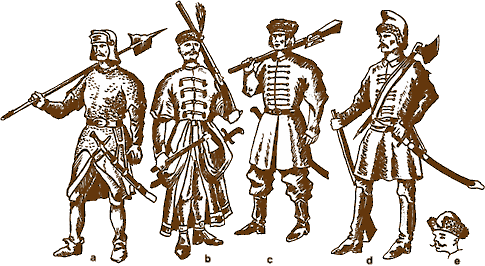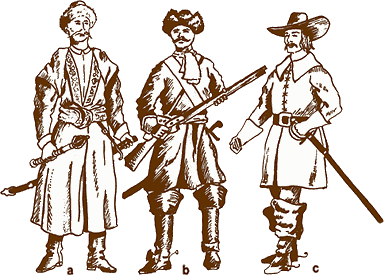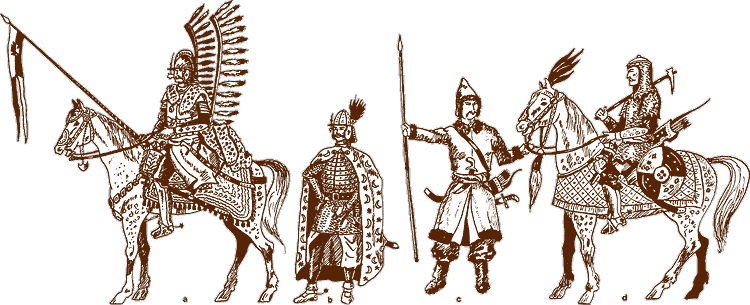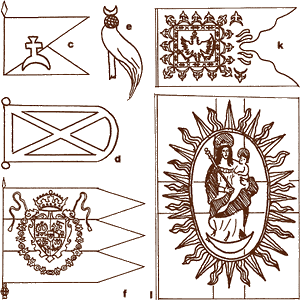Renaissance Armies: The Polish
An article by George Gush
 Throughout the Renaissance period, Poland was the chief power of Eastern Europe, possessing not only vast territories stretching from the Baltic to the Black Sea, and from Pomerania in the West eastward almost to the Don, but also with remarkably effective armed forces. Unique in their organization, tactics, and appearance, combining the tactics and weapons of East and West with traditional Polish gallantry and dash, they successfully took on Muscovites, Cossacks, Tartars, Turks, Austrians, Germans, Danes, Swedes and Wallachians; even the great Gustavus Adolphus based most of his military reforms on the lessons he learned in warfare against the Poles. Throughout the Renaissance period, Poland was the chief power of Eastern Europe, possessing not only vast territories stretching from the Baltic to the Black Sea, and from Pomerania in the West eastward almost to the Don, but also with remarkably effective armed forces. Unique in their organization, tactics, and appearance, combining the tactics and weapons of East and West with traditional Polish gallantry and dash, they successfully took on Muscovites, Cossacks, Tartars, Turks, Austrians, Germans, Danes, Swedes and Wallachians; even the great Gustavus Adolphus based most of his military reforms on the lessons he learned in warfare against the Poles.
Late 15th and 16th Century
In the late 15th Century the Polish army was raised, mainly through the nobility, only when urgently required. In the event of a major invasion, large numbers of additional gentry and town and peasant militia could be called out. The crack cavalry were Western-style knights in full plate armour, on armoured horses and equipped with the heavy medieval lance, supported by lighter lancers (mail and half-armour), and mounted crossbow and sword-and-shield men (half-armour). The poorer territory of Lithuania supplied mailed cavalry with spear and shield and Tartars with bows. Infantry were similar to medieval Western types, with many crossbow and pavise-men.
Lithuanian hussar of the early 17th Century—an example of the less wealthy hussar types which existed alongside the more elaborately equipped. He wears a Kapalin helmet with leather cheek plates and a long blue ribbon at the back; a steel breast plate over 3/4 mail; red sleeved tunic, buff leather skirt and close-fitting black boots. His cap is of lynx or wolf skin. Horse furniture brown leather with a buff leather square under the saddle. He carries a ten foot lance with blue pennon, two pistols in saddle holsters and a saber in a black leather scabbard.
|

|
In the 16th Century a small standing army was created, its weapons and equipment provided by the state. It was supported by German, Scottish, Hungarian, Czech and Dutch mercenaries. Extra Polish mercenary troops (often highly patriotic) were also hired when needed, and in a large-scale conflict could be supplemented by masses of gentry and peasant militia raised on the old lines.
Stephen Bathory (1576-86) continued reorganization, introducing new infantry formations of peasants from Royal estates. As ruler of Transylvania he was also responsible for introducing Hungarian and probably Wallachian troops.
Reorganization included an effective administration and the permanent division of the army into "Rotas". These corresponded to the Western company, being officially of 100 infantry or 50 cavalry (later cavalry rotas, called "Standards" had up to 200 men). There was no larger permanent organization in this period.
Infantry rotas could be grouped into a regiment, but this was not a tactical unit and the rotas still acted independently. On the battlefield, cavalry rotas were formed into "Hufs" up to several thousand strong. These were tactical units, but rotas or groups of rotas could readily be detached, for example, to deal with enemy reinforcements. Each rota was commanded by a "Rotmistrz" and had a standard, and in the case of infantry a drummer (with a small drum at the waist, beaten with a single mallet) and a bagpiper.

a. "Drab" of the early 16th Century, still wearing mail shirt and visored infantry helmet. The halberd shown could be replaced by a long-shafted berdische axe, or the soldier could carry an arquebus, b. Polish infantryman or Drabant, end of the 16th or early 17th Century. The plume probably indicates an NCO. NCOs would usually replace the arquebus with a half-pike with tassels below the head, c. Hungarian-style Polish infantryman of the 17th Century dressed in the style called "Hajduk". d. 17th Century musketeer. Note the three-foot long axe which was used as a musket rest. The figure could also have a fur cap with turned-up brim, e. Cap as worn by Cossacks and dragoons.
75 percent of this army was cavalry. The fully plate-armoured lancers survived up to the 1580s, though abandoning horse-armour by the '50s, but beside them grew up a new type, the famous "Hussars" who were to be the elite of Poland's cavalry until the 18th Century. They were copied from the Serbian "Usars" hired in the early 16th Century, un-armoured cavalry with lance, saber and squarish Turkish shield, though the Polish-Lithuanian type established by mid-century wore mail and helmet. By the 1580s they had adopted a cuirass over the mail, and replaced the armoured knight. The dismounted hussar shown is of this period, and as well as his saber would carry a long straight sword or "Koncerz" (used against armoured opponents), long lance with pennon, warhammer (Nadziak), and possibly shield.
The most extraordinary feature of the hussars was the wing worn by some units. Made from a curved batten carrying eagle or vulture feathers, this could be attached to the rear of the saddle, or by cross-belts to the shoulders, making its wearers some of the most spectacular soldiers ever seen, especially with the pair of wings sometimes worn in the 17th Century. They are said to have made a rushing tornado-like noise in a charge, with similar psychological effects to the Stuka's scream, and also to have protected those who wore them against Tartar and Cossack lassos.
Mounted crossbowmen changed to the arquebus early in the 16th Century, and hussars would be supported by a few mounted arquebusiers similarly equipped.
Lesser gentry provided medium cavalry or "Pancerni" ("Iron-clads"—see illustration). Additional weapons could include "Koncerz", or for Lithuanians a short lance, and some would replace bow and/or pistols with an arquebus. The shield was made of fig twigs bound together and covered with silk or leather.
Polish "Lisowski Cossack" of the early 17th Century. This regiment fought in Poland, Czechoslovakia, Germany, France and Italy in the period 1616-26. Maroon coat, trimmed gold. Green trousers, yellow boots, red hat. Could also carry arquebus or short lance. This probably gives an idea of the irregular Poles or Cossacks in Imperial armies of the 30 Years' War.
|

|
Light cavalry consisted, firstly, of Cossacks. Those living West of the Dnieper were under Polish suzerainty and known as "Loyal Cossacks" though actually somewhat addicted to rebellion. They wore fur hats, a long-sleeved caftan, baggy trousers and Polish boots and carried short lance, saber, and bow or arquebus.
Cossacks were hired from 1524 on, but it was Stephen Bathory who introduced, in 1571, the system of registering Cossacks (500 in his day) for regular service. Cossack standards seem to have been 320 strong.
Secondly, there were the Tartars illustrated, mostly settled in Lithuania; they could carry round shield and lariat as well as the weapons shown. Wallachians, armed like the Cossacks, were also used. All tended to wear light brown caftans, red trousers and black boots.
Infantry was mainly a support arm for the cavalry. Very early in the century plate armour and crossbows vanished, and the dress of the normal infantryman or "Drab" was standardized as shown. A rota of this period often formed in ten ranks of ten, the first being of NCOs with eight foot half-pikes, second and tenth armed with halberds or berdische poleaxes, the rest with arquebusses. Usual sidearm was a saber or light axe.
By the second half of the century mail had disappeared, and the infantry wore the uniform shown for a "Drabant". A long coat, slit to the waist at each side, was worn over a tunic and tight trousers. The front quarters were pulled up and tucked through the belt. A flat fur-trimmed hat replaced the helmet. Coat commonly light blue with red lining, trousers black, shoes black or brown.

a. Typical gentry dress worn by Polish officers, called "Kontusz". It was a long tunic worn over a shirt and breeches. An embroidered sash was worn with it. All colors were used, but usually in a subdued hue—for example, dark green or red instead of bright green or red. Over the kontusz was worn either a Iong cape or a long sleeved coat with a wide fur collar. Both had slits in the sides, through which the arms went. The capes and coats were mainly in buff, light brown or dark brown colors. A wide variety of fur hats was worn, of different shapes and colors. These were usually crowned with heron feathers, b. A mid-17th Century dragoon, shown dismounted. Horse furniture was plain brown leather. He wears a brown fur hat with, a red top, red tunic with white kerchief at neck, yellow gauntlets and dark brown boots. The wide and narrow bandoliers holding charges are light brown leather. Scabbard is black or green leather. Most units wore red (and were sometimes called "redcoats"), but some favored blue tunics of a darker hue. c. Polish Rajtar, mid-17th Century. He wears a brown felt hat, wide brown belt, brown trousers and boots, with a long buff leather coat and white gauntlets. He would be armed with two pistols as well as the long sword illustrated, or a rapier.
Infantry NCOs retained their half-pikes, the rest having arquebus or musket; halberds were now largely used by bodyguards; (Royal Guard wore red coat with yellow lining and gold trim, gold-embroidered sash, light blue trousers and cuffs, yellow shoes.)
Hungarian like Polish infantry had ten percent half-pikes, 90 percent firearms, but wore the dress illustrated, while German infantry were armoured pikemen and un-armoured "shot" in morions, employing larger formations and Western tactics. (In the 17th Century at least, the bulk of these "Foreign" troops were actually Polish.)
Variously-armed peasant infantry would also be mobilized, and they would wear a fur cap, fur-trimmed and hooded caftan worn (in winter) over creamy-white linen tunic and trousers and high boots.
The 17th Century
Though the Polish state declined, the army remained very formidable. All the late 16th Century types remained in service. The infantry, who increased in recruitment and importance, would be replacing the arquebus with the musket, and by mid-century the Polish infantry were adopting the new dress shown, still usually light blue, with red collar, frogging, sash and trousers and black boots. The two-handed berdische axe doubling as musket-rest made a formidable armament.

a. A 17th Century "winged" hussar. His armour could be inlaid with brass. The feathers are natural, the wooden wing frame gilt. Lance pennon red and white. Cloak of panther, tiger, lynx or wolf skin. Coat red, brown or deep blue, boots red or yellow. Basic color of saddle cloth wine red. Scabbards red, green or black with silver or gilt fittings. b. A 16th Century hussar whose saddle would carry a single "wing" of black feathers on a red frame. His helmet plume is black, cloak red with white decorations. His coat and saddle cloth would probably be red, trousers black and boots yellow. This figure wears a breast plate over mail, but could be dressed in mail only. Officers would have fur-trimmed caps, panther or tiger skin cloaks, and carry gilt maces. Both would have horse furniture as on 'a', but 'b' would have a feather plume on the horse's head. c. 16th-17th Century Lithuanian Tartar. The cap could have a large turned-up fur brim, d. 17th Century Pancerni cavalryman. Harness etc yellow, red, green or blue with gilt or silver studs and fittings. Trappings usually some shade of red with silver or gilt fringes. Officers would carry a gilt mace, and might wear a fur-trimmed cap with long, trailing point.
The aristocratic hussar became still heavier and more ornate, with three-quarter plate armour and pistols, like the mounted figure shown.
Cossacks were employed in increasing numbers. By 1625 Poland had six regiments, each 1,000 strong. In the mid-17th Century the registered Cossacks wore white coats.
Three new cavalry types introduced at this time illustrate the Poles' readiness to adopt what was best from their enemies.
Mounted arquebusiers in foreign style were added to the heavy cavalry. They wore helmet and cuirass and carried an arquebus, a pair of pistols, and a rapier.
The "Rajtar" was a new medium cavalryman, mainly depending on missile power and armed with a sword and two pistols. He was dressed plainly, in the style of his Swedish prototypes, with broad-brimmed felt hat, wide white collar, buff coat, red trousers and wide knee-boots, with plain leather horse-furniture.
a. A Polish peasant infantryman of the early 17th Century in winter dress. He wears a fur cap, hooded coat with fur trim (all brown) and trousers, probably of unbleached wool or linen, tucked into high boots, b. 17th Century Polish infantry officer in fur cap with red plume, yellow shirt with buff coat and breeches with brown inserts, grey stockings and yellow shoes. Cloak blue with red lining. Officers usually dressed quite differently from the men, and often carried maces. Red or yellow were favored for boots and shoes, c. A Polish Guardsman, 16th-17th Century. Yellow cap with brown rim and grey plume. Red coat with yellow lining, braid and collar piping, blue cuffs. Blue stockings, yellow shoes.
|

|
The Dragoons carried a musket, two pistols, axe and saber, and remained primarily mounted infantry until the late 17th Century. Their plain, full-skirted tunic was red for most units, blue for a few, trousers black, boots tan, and horse-furniture plain leather. They were distinguished from their Western equivalents by their caps, of the Cossack style illustrated.
By the second half of the 17th Century the Polish cavalry were 20 percent hussars, 20 percent light cavalry, 60 percent Pancerni, Rajtars, and Dragoons; earlier the proportions of hussars and light cavalry would be higher.
Artillery
At first relatively backward in this arm, Poland made great efforts to develop the artillery. German and Dutch experts were brought in and arsenals were set up. By the end of the 16th Century it was quite effective. In the 17th Century it was greatly increased and by the second half of the century recognized as among the best in Europe.
The Poles produced first-class guns of standardized caliber, 3 pounder, and 6 pounder "Octavs" were used to support infantry and "Kartaunas" (cannon) of 12, 24, and even 48-pounder sizes were apparently used in the field also. For siege work there were even larger "Kolyubrynas" and mortars up to 125 pounders.
Gunners were not actually uniformed but would usually be dressed in a simpler version of the clothing shown for a "Drabant", probably in blue.
Officers of artillery were mainly European mercenaries who would wear their own style of dress, with plumed broad-brimmed hats and so on
The Tabor
The baggage train or "Tabor" was an important part of the army. The Poles adapted from the Czechs and Cossacks a train specially designed for tactical use. It was particularly important in Eastern territories, where there were few towns or fortified places. Both wagons and horses were protected by thick wooden mantlets, and the wagons were adapted to be pushed as well as pulled. They could be hitched together, and on the move up to 40 wagons formed a continuous train, a team of two horses being hitched to every second wagon, and one of four to every fourth one. Chief battle use was as a fortified base. The wagons, linked up in double lines, formed an oblong, often with artillery at the corners. The short sides of the oblong were of a single row, with teams still harnessed up, thus they could be suddenly opened for a surprise sortie by the Polish cavalry, a very successful tactic, as, for example at Obertyn (1530) where the Poles beat over three times their number of Wallachians.
 Wagons of the "Tabor" or wagon train showing the protective mantlets and frames for attaching them together.
Wagons of the "Tabor" or wagon train showing the protective mantlets and frames for attaching them together.
In emergency, the tabor could even be used in the attack. To escape a surprise by stronger forces, the wagons, packed with infantry, were formed into several small columns and driven full-tilt at the enemy centre, the cavalry riding on the flanks and exploiting the break-through. This actually worked on more than one occasion, though at the cost of losing the slower-moving artillery.
Tactics
The usual formation for a Polish army—the "Horns"—is shown. The heavy cavalry Hufs were drawn up three ranks deep, the mediums four. Less experienced troops among the latter were kept in the "Black Huf". The rear hufs were spaced a good distance behind the front ones to allow for maneuver.
The Poles usually started with a weak attack from one wing to fix the enemy's attention. Next the light cavalry began to envelop him, causing his forces to bunch together. The heavy hussars then charged into the thick of them, the gap thus opened being exploited by the mediums; finally the light cavalry took up the pursuit. However, their tactics were varied, based on the flexibility conferred by their cavalry organization and the almost unstoppable full-gallop charge of the heavy and medium cavalry.
 Typical Polish order of battle, 16th-17th century.
Typical Polish order of battle, 16th-17th century.
Polish Flags
a. Pancerni standard. Colors red with gold wreath and eagle, b. Dragoon standard. Light blue top, black bottom, with cross in reversed colors, c. Cossack flag. White top, red bottom, with yellow cross and crescent. a. and e. Tartar flag and horsetail pennant. Colors on the flag red, with yellow edging and cross. Horsetail could be any color, formed into a bun held by a gold net and topped with a gold or silver crescent, f. Polish royal standard, 16th-17th Century. Top and bottom stripes very deep crimson, middle stripe white. Crown, scroll around shield and jeweled chain, gold outlined black. Coat of arms—red shield with white or silver Polish eagles and Lithuanian "pursuit" emblems of gold riders holding light blue shields, on white horses. The small shield in the centre is light blue, with three white feathers. The ornamental ropes are light blue, terminating in gold tassels. The jewels on the chain and the crown are alternately deep red and deep blue. The haft of the standard is bright red, striped in gold, with a gold point. Size of the standard was approximately eight feet high and nine wide! g. Heavy hussar standard. White with green wreath and letter 'S'. h. to j. Heavy hussar lance pennants (uniform for each "rota"), 'h' is a 16th Century pennant in red and blue, starting with blue at the haft 'i" is 17th Century with a white top and red bottom, the cross and swallows' tails being reversed. "j" is also a 17th Century pennant, with yellow top and white bottom, swallows' tails reversed colors. k. 17th Century cavalry flag. l. Polish flag, showing centre only. Whole flag was square. Ground is blue with gold cross and ornaments. Shaded part of Virgin's robe red. The reverse side of the flag carries the collar of the Order of the Golden Fleece, surrounding the combined arms of Sweden and Poland. This probably dates from the 1630s-50s, the Swedish design showing the claim of 17th Century Polish kings to the Swedish throne. m. Polish pennon, first half of 16th Century. Red with gold device.

|


|
About the Author
George Gush was educated at Tonbridge School, Kent, and won an Open Scholarship in History to Christ Church, Oxford, and has pursued a teaching career ever since graduation.
Acknowledgements
Article contents originally © Copyright George Gush and Patrick Stephens, Ltd 1975, 1982 and reproduced here with permission.
|
|

